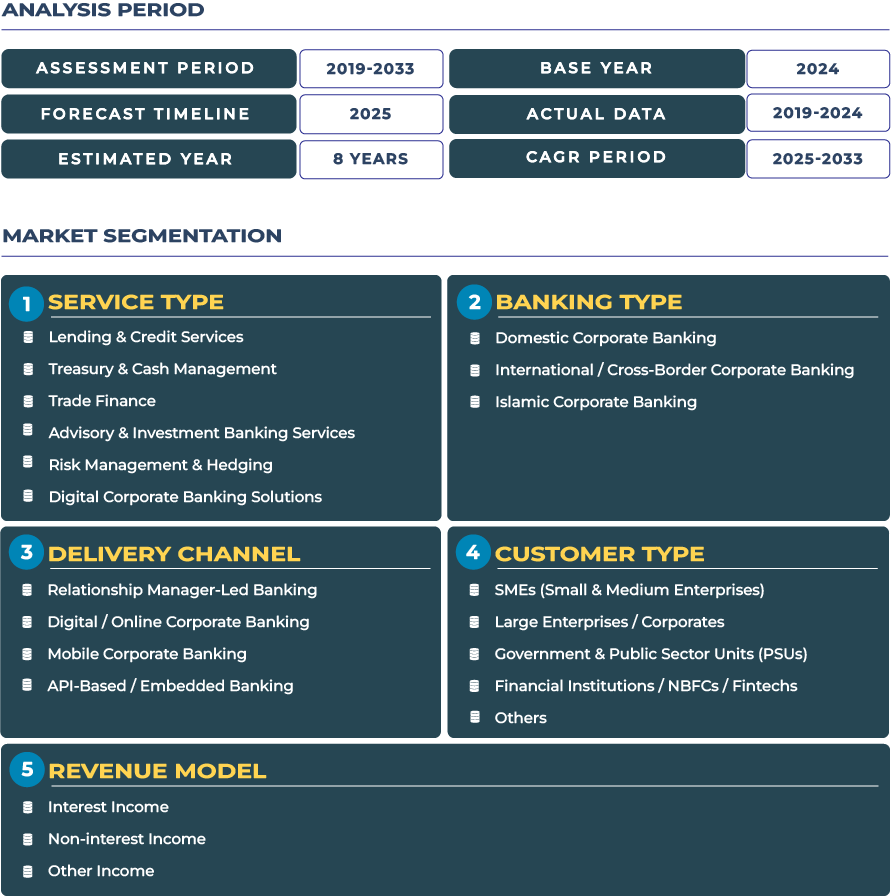AI-Powered Cash Management Solutions in US Corporate Banking: Driving Real-Time Analytics and Efficiency
In the evolving US corporate banking sector, financial institutions are embracing AI and analytics to transform cash management for both small and large enterprises. Real-time dashboards now provide visibility into multi-entity treasury positions, enabling dynamic liquidity allocation and instantaneous intra-day sweeping. Banks increasingly partner with fintechs to embed predictive cash positioning tools and anomaly alerts directly into corporate ERP systems. This shift is particularly crucial for corporate clients with complex cash flows, cross-border operations, and high-frequency receivables/payables cycles. The US corporate banking market, estimated at USD 453.7 billion in 2025 and projected to grow to USD 525.2 billion by 2033 (at a CAGR of 1.8%), reflects a measured but sustained appetite for such advanced digital offerings. The comparatively moderate growth trajectory underscores structural headwinds and competitive pressures, but banks that successfully deliver differentiated AI-driven cash management solutions are well placed to capture the next wave of corporate demand.
Note:* The market size refers to the total revenue generated by banks through interest income, non-interest income, and other ancillary sources.
US Corporate Banking Market Outlook: How AI and Analytics Propel US Corporate Banking Forward
The future of the US corporate banking market centers on the symbiosis of technological sophistication and client-centric services. Corporate treasurers demand actionable insights, instantaneous payment flows, and seamless integrations with financial systems. In response, leading banks such as J.P. Morgan Chase are embedding APIs and cloud-native modules to support real-time cash visibility, virtual accounts, and predictive liquidity forecasts. The intensifying focus on embedded corporate finance and ecosystem partnerships enables banks to rise above commoditized services. At the same time, macroeconomic headwinds, sluggish business investment, rate normalization, inflation pressures, and geopolitical uncertainty, constrain aggressive expansion. The US banking sector must reconcile its promise of fintech-enabled innovation with capital discipline and regulatory compliance. Yet by leveraging technological differentiation and deepened client relationships, the corporate banking ecosystem can sustain resilience in the face of evolving global challenges.
Drivers & Restraints: Navigating the Imperatives and Barriers in US Corporate Banking
Drivers: Corporate Liquidity Demand, Fintech Integration, and merger and acquisition Financing Momentum
Three core forces drive momentum in the US corporate banking industry. First, large corporates maintain significant intra-day liquidity reserves across subsidiaries, demanding real-time cash visibility, sweeping, and working capital efficiency. This internal cash demand underpins strong adoption of advanced treasury modules. Second, fintech adoption is accelerating within treasury and payments functions, bank–fintech partnerships are enabling banks to deliver embedded payments, dynamic discounting, and supply chain finance programs with greater agility. For example, API integrations enable corporate systems to originate ACH or instant payments directly, as highlighted by U.S. Bank’s insights on treasury APIs. Third, robust private equity and merger and acquisition activity fuels demand for acquisition finance, refinancing, and cross-border advisory services. The rebound in investment banking deal volumes further supports fee-based revenue streams, helping banks offset margin compression in credit products.
Restraints: Fragmented Regulation, Non-Bank Competition & Partnership Volatility
While digital transformation offers opportunity, several constraints challenge scaling. The US banking system is complicated by fragmented state and federal regulatory regimes, for instance, payment and money transmission laws across states complicate deployment of nationwide embedded finance solutions. Secondly, large technology platforms and non-bank fintechs increasingly encroach on corporate payments and treasury services, disciplining margins and raising the bar for differentiation. Thirdly, fintech partnerships, while enabling innovation, introduce churn and integration risk; if a fintech partner fails or pivots, banks may face disruption or client dissatisfaction. These restraints make strategic execution and risk governance critical in deploying new corporate banking capabilities.
Trends & Opportunities: Signals and Growth Levers in US Corporate Banking
Trend: API Banking, Open Platforms & Outsourced Treasury Adoption
A defining trend in the US corporate banking sector is the proliferation of open APIs and platform-based corporate finance solutions. Companies are increasingly outsourcing treasury operations to fintech-enabled platforms, which can aggregate multi-bank accounts, perform sweeps, and execute payments across jurisdictions. The expansion of the FedNow Service and RTP network underscores the infrastructure supporting instant corporate transactions. As U.S. Bank notes, APIs now facilitate real-time connectivity between banks and corporate ERP systems, enabling account balance queries and payment initiation per second. This connectivity is rapidly establishing API banking and embedded finance as the connective tissue of modern corporate banking.
Opportunity: AR Automation, Liquidity Sweeping & Invoice Tokenization Services
Banks that build bespoke AR automation tools, real-time liquidity sweeping services, and invoice tokenization platforms are positioned to win. AR automation reduces days-sales-outstanding, while sweeping keeps excess cash concentrated. Invoice tokenization enables receivables to be traded or pledged as collateral, improving financing flexibility. Especially for large corporates, tokenization bridges credit with capital markets, unlocking liquidity anchored in receivables. By offering these advanced products, banks deepen customer stickiness and differentiate beyond traditional lending.
Competitive Landscape: Modular Platforms, Fintech JVs & Tokenized Receivables
Leading US corporate banks are transforming strategy through modular treasury platforms, joint fintech ventures (JVs), and tokenization innovation. For example, banks are increasingly offering API-first treasury modules to multinational clients, enabling lightweight integration and incremental adoption. Captive fintech JVs focused on B2B payables or buy-now-pay-later, allow banks to monetize new value chains while retaining customer control. Some banks are developing invoice tokenization platforms that allow clients to convert receivables into tradeable assets, reducing DSO and credit risk. The recent merger between Fifth Third and Comerica, valued at USD 10.9 billion, is emblematic of regional consolidation aimed at scaling commercial banking capabilities and expanding service reach. Such consolidation may pressure middle-tier banks to adopt modular strategies or partner aggressively to remain competitive.







